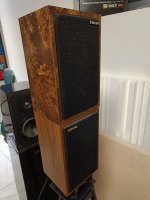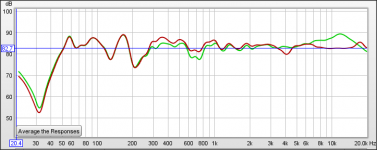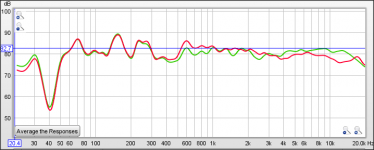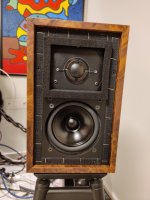Dirac could possibly correct that. Up to 500Hz licenced as in the NAD M10 V2 streaming amp should be enough.
I’d spend your money on a pair of KEF LS50s and a good sub bass. For c £1800 all in there’s very little to compete - and I’ve listened to speakers all the way up to £ 50k a pair.
The original LS3s were a revelation in their day, but that was over 40 yrs ago - things have improved dramatically since then.
🙂
The original LS3s were a revelation in their day, but that was over 40 yrs ago - things have improved dramatically since then.
🙂
Last edited by a moderator:
Looking at the measurements they are all over the place depending on who makes them and when. Seems like a crapshoot on whether one can even get a familiar sound.
https://www.stereophile.com/content/bbc-ls35a-loudspeaker-1989-measurements
https://www.stereophile.com/content/falcon-acoustics-ls35a-loudspeaker-measurements
https://www.stereophile.com/content/falcon-gold-badge-ls35a-loudspeaker-measurements
https://www.stereophile.com/content/bbc-ls35a-loudspeaker-1989-measurements
https://www.stereophile.com/content/falcon-acoustics-ls35a-loudspeaker-measurements
https://www.stereophile.com/content/falcon-gold-badge-ls35a-loudspeaker-measurements
There are differences between licenced makers indeed. From subtle to right away noticeable. They especially never seem to follow a specific HF level not to mention a specific HF curve shape. At least in my experience with four or five brands.
Definitely. Each company's version had a "house sound", with production variations within that sound.
As I recall, to be approved each company had to submit ten finished speakers to the BBC for testing.
Naturally, those initial speakers were very carefully assembled, but later production would vary.
It's doubtful whether more than a few have ever heard what a proper classic LS3/5A can really do.
I've heard the initial production vs later production, and the differences are not minor.
Maybe the Falcon gold badge series are better.
Naturally, those initial speakers were very carefully assembled, but later production would vary.
It's doubtful whether more than a few have ever heard what a proper classic LS3/5A can really do.
I've heard the initial production vs later production, and the differences are not minor.
Maybe the Falcon gold badge series are better.
Its obvious even over an iPhone recorded TouTube clip, isn't it?
Might be due to components drifting out of spec.
We have no way of knowing if they would have sounded more similar when they were just run-in.
All the LS3/5As that I tested were brand new, and just out of the box. The unit to unit variation was significant
and easily audible.
and easily audible.
Some measurements I took at a friend's rather small listening space today. Between Falcon Gold Badge and Stirling V2. First graph is for single speaker with mic at one meter distance at tweeter height. Second graph is for a pair of same version speakers playing with mic at two and a half meters distance listening position at ear height. Green line is Falcon, red line is Stirling in both graphs. Grills on in all cases. Smoothing is per one sixth octave.
Attachments
In a small room any REW, ARTA etc.etc. measurement below 1000 Hz is highly unreliable. Get the speakers at least 2 metres from the nearest surface and try again..
Oops, meant to say :could you redo the measurements with at last 2 meters from speaker to nearest surface?
The TS of a rubber surround 40 year old B110 woofer will have drifted dramatically from stock.Might be due to components drifting out of spec.
https://www.diyaudio.com/community/threads/jr149-redesign.269455/
Certainly up to 300Hz those curves match perfectly, thus the room is fully dominant in that range. Although I didn't get the chance of measuring them in my own space and leisure for making better arrangements, we can still see how they deviate in higher frequencies. In other words circumstances and time allowance were poor to properly characterize the two speakers individually but able to see how they differ when all other things are equal. I also later noticed that my stereo pair curves generally follow the Stereophile room averaged trends for the particular LS3/5A editions. Mostly above the first few hundred Hz.In a small room any REW, ARTA etc.etc. measurement below 1000 Hz is highly unreliable. Get the speakers at least 2 metres from the nearest surface and try again..
By the way, here's a picture of that Burr Walnut Falcon with grill off. The tripod stand that it sits on is Italian, Solidsteel brand.
Attachments
Unfortunately no. The space they belong to doesn't allow for that. Maybe in springtime with long cables in a small yard located next to that mancave.Oops, meant to say :could you redo the measurements with at last 2 meters from speaker to nearest surface?
Does anyone here know what cone that Falcon midwoofer uses? It looks like a coated paper job, or is it coated bextrene?
And what tweeter is used? It does not at all look like the usual suspects, but rather like a HF 2000 remake.
And what tweeter is used? It does not at all look like the usual suspects, but rather like a HF 2000 remake.
There is a subwoofer for 3/5a with b110 bass driver in 4th order usable as a stand for the 3/5a.
But you could easily use eq to flatten the response at 100hertz and linearized it down to 50 hertz as long as you keep the loudness at appropriate level.
Or you can listen quite loud as long source meterial is not bassy like voice and guitar and so on
But you could easily use eq to flatten the response at 100hertz and linearized it down to 50 hertz as long as you keep the loudness at appropriate level.
Or you can listen quite loud as long source meterial is not bassy like voice and guitar and so on
- Home
- Loudspeakers
- Multi-Way
- Rogers LS3/5a



